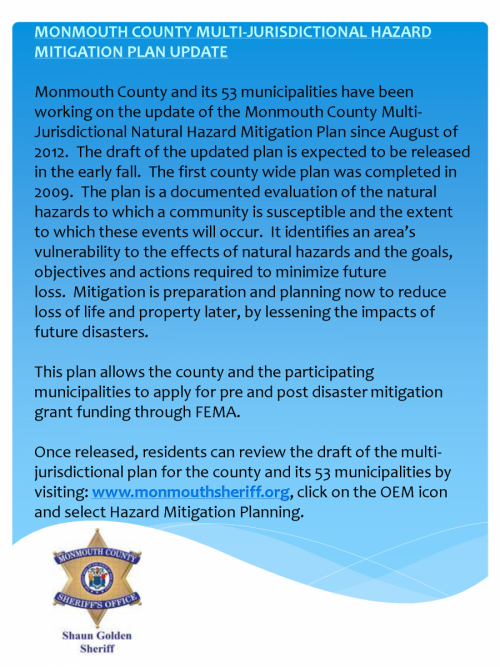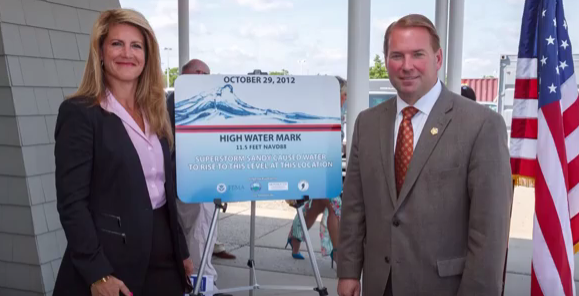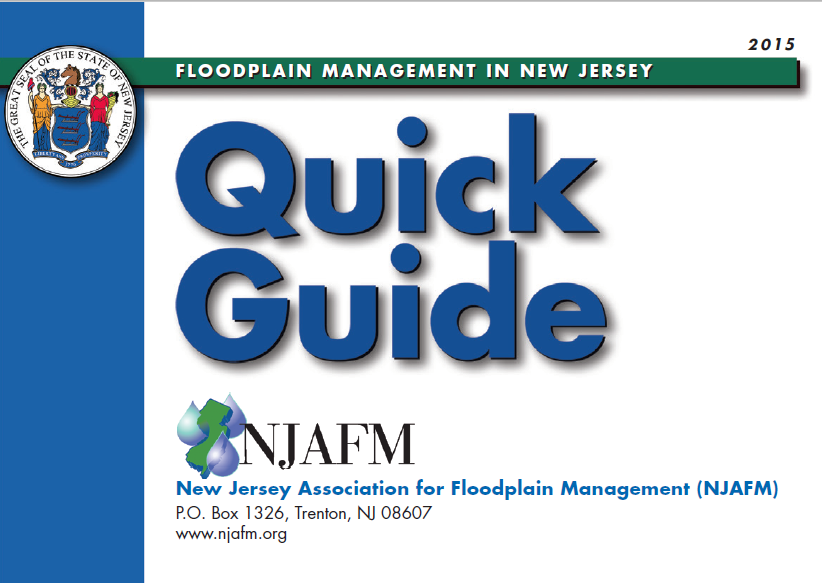FLOODPLAIN ADMINISTRATOR
Neptune is participating in the High Watermark Initiative.
Click on the picture below for the High Watermark Initiative Launch video.
FEMA Flood Map Service Center
Find if your home is in a flood zone
The FEMA Flood Map Service Center (MSC) is the official public source for flood hazard information produced in support of the National Flood Insurance Program (NFIP). Use the MSC to find your official flood map, access a range of other flood hazard products, and take advantage of tools for better understanding flood risk.
FEMA flood maps are continually updated through a variety of processes. Effective information that you download or print from this site may change or become superseded by new maps over time. For additional information, please see the Flood Hazard Mapping Updates Overview Fact Sheet
Click on the icon below for the 74 page Quick Guide on Floodplain Management
June 2015
The following is a revision to DCA Guidance on Electrical Meter Placement in a Designated Flood Zone.
Please review the documents below for detailed drawings of meter installation requirements and meter landings. The drawings have been updated to provide additional clarity regarding base flood elevation levels and the landing location.
Attached is the link to FirstEnergy website to view the entire document:https://www.firstenergycorp.com/service_requests/request-electrical-work/jcpl-meter-placement.html
JCP&L, A FirstEnergy Company
Customer Service: 1-800-544-4877
Review, Update Your Insurance Policies
EATONTOWN, N.J. - September is National Preparedness Month, and the latter half of the year is an ideal time for people to review their insurance policies. Understanding the details of what specific policies cover and what the policyholder is responsible for after a disaster is important as both clients’ needs and insurance companies’ rules change.
Insurers’ decisions and legislative changes have the biggest effect on changes in policies. Consumers should make themselves aware of possible changes in these areas and know what to look for while reviewing their policies.
What’s Covered
The first check is the most obvious: the actual coverage. Policyholders should look at the specifics of which property is covered and the type of damage that is covered. Property owners should know that floods are not covered by standard insurance policies and that separate flood insurance is available. Flood insurance is required for homes and buildings located in federally designated high risk areas with federally backed mortgages, referred to as Special Flood Hazard Areas (SFHAs). Residents of communities that participate in the National Flood Insurance Program (NFIP) are automatically eligible to buy flood insurance. According to www.floodsmart.gov, mortgage lenders can also require property owners in moderate to low-risk areas to purchase flood insurance.
There are two types of flood insurance coverage: Building Property and Personal Property. Building Property covers the structure, electrical, plumbing, and heating and air conditioning systems. Personal Property, which is purchased separately, covers furniture, portable kitchen appliances, food freezers, laundry equipment, and service vehicles such as tractors.
What’s Not Covered
Policy exclusions describe coverage limits or how coverage can be purchased separately, if possible. Property owners should know that not only is flood insurance separate from property (homeowners) insurance, but that standard policies may not cover personal items damaged by flooding. In these cases, additional contents insurance can be purchased as an add-on at an additional cost. Some policies may include coverage, but set coverage limits that will pay only a percentage of the entire loss or a specific dollar amount.
The Federal Emergency Management Agency’s Standard Flood Insurance Program (SFIP) “only covers direct physical loss to structures by flooding,” FEMA officials said. The SFIP has very specific definitions of what a flood is and what it considers flood damage. “Earth movement” caused by flooding, such as a landslide, sinkholes and destabilization of land, is not covered by SFIP.
Structures that are elevated must be built at least to the minimum Base Flood Elevation (BFE) standards as determined by the Flood Insurance Rate Maps (FIRMs). There may be coverage limitations regarding personal property in areas below the lowest elevated floor of an elevated building.
Cost Impact of Biggert-Waters
The Biggert-Waters Flood Insurance Reform Act of 2012 extends and reforms the NFIP for five years by adjusting rate subsidies and premium rates. Approximately 20 percent of NFIP policies pay subsidized premiums, and the 5 percent of those policyholders with subsidized policies for non-primary residences and businesses will see a 25 percent annual increase immediately. A Reserve Fund assessment charge will be added to the 80 percent of policies that pay full-risk premiums. Un-elevated properties constructed in a SFHA before a community adopted its initial FIRMs will be affected most by rate changes.
In March 2014, the Consolidated Appropriations Act of 2014 and the Homeowner Flood Insurance Affordability Act (HFIAA) of 2014 were signed into law, lowering rate increases on some policies, preventing rate increases on others, and delaying the implementation of Section 207 of Biggert-Waters, which was to ensure that certain properties’ flood insurance rates reflected their full risk after a mapping change or update. HFIAA also repeals a portion of Biggert-Waters that eliminatedgrandfathering properties into lower risk classes. Many of the changes have not yet been implemented because the necessary new programs and procedures have not been established.
Other Conditions
The General Conditions section informs the consumer and the insurer of their responsibilities, including fraud, policy cancellation, subrogation (in this case, the insurer’s right to claim damages caused by a third party) and payment plans. Policies also have a section that offers guidance on the steps to take when damage or loss occurs. It includes notifying the insurer as soon as practically possible, notifying the police (if appropriate or necessary) and taking steps to protect property from further damage.
“FEMA’s top priority is to provide assistance to those in need as quickly as possible, while also meeting our requirements under the law,” FEMA press secretary Dan Watson said. “To do this, FEMA works with its private sector, write-your-own insurance (WYO) company partners who sell flood insurance under their own names and are responsible for the adjustment of their policy holders’ claims.”
Policyholders should speak with their insurance agent or representative if they have any questions about coverage.
For further information and direction, call the NFIP Call Center at 1-800-427-4661 or the NFIP Referral Center at 1-888-379-9531 . Comprehensive information about NFIP, Biggert-Waters, HFIAA and flood insurance in general can be found at the official NFIP website, www.floodsmart.gov
How to Pump Out a Flooded Basement
Click on the link above for directions on how to SAFELY pump out a flooded basement
| Instructions | Converting Existing Elevations |
| Block 1 to 399 | Block 400 to 450 |
| Block 451 to Block 499 | Block 502.01 Lot 1386 |
| Block 557 Lot 1 | Flood Report |

Click on the icon below for the County’s Hazard Mitigation Plan Updates

FEMA recently released this fact sheet on the Homeowners Flood Insurance Affordability Act. (June 25, 2014)
Click here for the fact sheet (two pages).
FEMA has released the new Preliminary Maps which are the next step to generating new FIRM (Flood Insurance Rate Maps). These maps can be utilized with the link tools provided for the general public to find their current Flood Elevation. This is an important tool to find your current flood zone and elevation. For flood elevations, these maps are the next step from the ABFE maps for flood insurance purposes. The Preliminary Maps are the basis for what the insurance companies will base your flood insurance on. Please be advised that these maps are “Preliminary” and are just being introduced. The public is encouraged to review them and the flood elevations with respect to your property
For Township purposes and elevating of structures the current ordinance relies on the ABFE maps and an elevation of 12 which includes the necessary freeboard. This will be in place until the new FIRM maps have been through comment period and review and are adopted as the official FIRM maps. At that time the Township will evaluate how this compares to the ABFE’s and the adopted elevation of 12 to the new FIRM maps and see if any revisions are necessary to the current ordinance.
The following links are very helpful for individuals to locate their property
http://www.fema.gov/view-your-
http://www.fema.gov/
- Flood Maps
- Flood Zone Determinations
- Requirements for Construction in Flood Zones including Elevating Structures
- Flood Protection Advice
- Flood Insurance Requirements
- Increased Cost of Compliance Coverage
A wealth of information may be found at: www.floodsmart.gov




